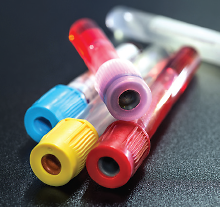Journal Digest
Polycystic Ovary Syndrome May Increase Autism Risk in Offspring

Children born to mothers with polycystic ovary syndrome (PCOS)—a condition associated with excess androgens—appear to have a higher risk of developing autism spectrum disorder (ASD) than children whose mothers do not have the disorder, according to a study published in Molecular Psychiatry.
For the study, researchers from Karolinska Institutet analyzed the health records of more than 220,000 Swedish youth (aged 4 to 17) and their mothers.
The results showed that maternal PCOS increased the odds of ASD in offspring by 59 percent. These odds were further increased in children who were born to mothers with both PCOS and obesity, a condition common to PCOS that is related to more severe hyperandrogenemia. The ASD risk associated with PCOS was similar in male and female offspring.
“Our results support that early life androgen exposure may be important for the development of autism in both sexes and call for further research on the mechanisms involving sex steroids in the etiology of ASD,” the study authors wrote.
Kosidou K, Dalman C, Widman L, et al. Maternal Polycystic Ovary Syndrome and the Risk of Autism Spectrum Disorders in the Offspring: A Population-Based Nationwide Study in Sweden. Mol Psychiatry. Dec 8, 2015. [Epub ahead of print]
Social Media May Offer Public MH Educational Opportunity

The popular social media website Pinterest may be doing more than letting individuals share interests via photos; it may also serve as an outlet for people to express their state of emotions at the time of posting.
Researchers from the Center for Health and Risk Communication at Grady College and the Department of Social Behavioral Sciences at Virginia Commonwealth University analyzed nearly 800 depression-focused Pinterest posts.
The researchers found that “more than half of the pins [Pinterest posts] referred to the seriousness and severity of depression,” and about 10 percent of the pins referred to thoughts of suicide.
The researchers also observed ineffective coping strategies for depression being displayed among the posts such as behavioral disengagement, self-blame, or denial, in addition to an absence of health care professionals and medical organizations on the social media site to address these issues.
“Conversations on social media platforms … can provide insight into how both depression sufferers and others engage in conversation about this disorder outside of a formal health care setting,” said study coauthor Jeanine Guidry, a doctoral student in the Department of Social Behavioral Sciences at Virginia Commonwealth University.
The researchers suggested that the findings showcase a need for health professionals and health public relations professionals to use visual media platforms to effectively engage and educate high-risk groups.
Guidrya, J, Zhangb, Y, Jin, Y, et al. Portrayals of Depression on Pinterest and Why Public Relations Practitioners Should Care. Public Relations Review. Sept 19, 2015. [Epub ahead of print]
Childhood Bullying Increases Risk of Psychiatric Problems Later in Life

Exposure to bullying during childhood is associated with psychiatric problems later in life, according to a study published in JAMA Psychiatry.
The study included 5,034 individuals from Finland who were surveyed on childhood bullying behavior at age 8 and were followed up at age 29 for psychiatric outcomes. The use of specialized services for psychiatric disorders from age 16 to 29 years of age was obtained from a nationwide hospital register, including outpatient and inpatient treatment.
The results showed that 20 percent of individuals who served as perpetrators of bullying, 23.1 percent of people who were victims of bullying, and 31.2 percent of those who served as both a perpetrator and victim of bullying had received a psychiatric diagnosis by age 29. In contrast, 11.5 percent of those who had no involvement with or exposure to bullying had received psychiatric diagnoses by this age.
“Exposure to bullying, even in the absence of childhood psychiatric symptoms, is associated with severe adulthood psychiatric outcomes that require treatment in specialized services,” the study authors noted. “Early intervention among those involved in bullying can prevent long-term consequences.”
Sourander A, Gyllenberg D, Brunstein K, et al. Association of Bullying Behavior at 8 Years of Age and Use of Specialized Services for Psychiatric Disorders by 29 Years of Age. JAMA Psychiatry. Dec 9, 2015. [Epub ahead of print]
Set of Blood Proteins Might Help Differentiate Depressive Disorders

A research team at the Mayo Clinic has identified six proteins found in blood serum that might help identify and distinguish bipolar depression from other mood disorders.
For this proteomic analysis, which was published in Translational Psychiatry, researchers took blood samples from 147 patients with depression (52 unipolar, 46 bipolar I, and 49 bipolar II) and 141 matched controls and compared the expression of over 300 proteins.
While 73 proteins showed some variance among these four groups, there were six with significant differences: growth differentiation factor 15 (GDF-15), hemopexin (HPX), hepsin (HPN), matrix metalloproteinase-7 (MMP-7), retinol-binding protein 4 (RBP-4), and transthyretin (TTR).
Further analyses showed that MMP-7 was significantly different in all three mood disorder groups compared with controls; MMP-7, GDF-15, and HPN were significantly different in both bipolar cases compared with controls, and GDF-15, HPX, HPN, RBP-4, and TTR proteins were all significantly different in bipolar I subjects compared with controls.
The authors cautioned that although the sample size was small and they did not factor in medication status, the results “support the possibility of developing a diagnostic test using the discovered biomarkers, which will need validation, to help facilitate accurate diagnosis and rapid treatment initiation with improved clinical outcomes.” ■
Frye M, Nassan M, Jenkins G, et al. Feasibility of Investigating Differential Proteomic Expression in Depression: Implications for Biomarker Development in Mood Disorders. Transl Psychiatry. Dec 8, 2015: e689.



